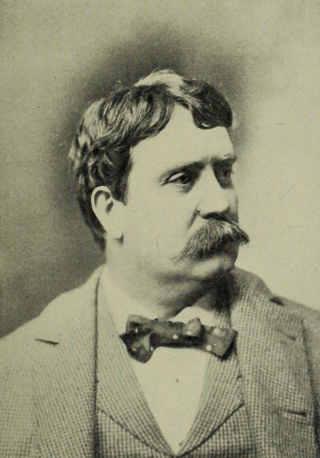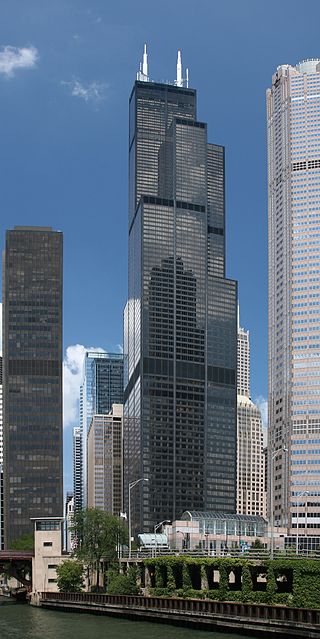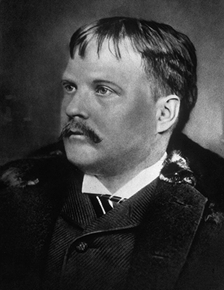This article needs additional citations for verification .(December 2009) |
| |||
|---|---|---|---|
| Buildings and structures +... |
The year 1892 in architecture involved some significant events.
This article needs additional citations for verification .(December 2009) |
| |||
|---|---|---|---|
| Buildings and structures +... |
The year 1892 in architecture involved some significant events.



Daniel Hudson Burnham was an American architect and urban designer. A proponent of the Beaux-Arts movement, he may have been "the most successful power broker the American architectural profession has ever produced."

The World's Columbian Exposition, also known as the Chicago World's Fair, was a world's fair held in Chicago from May 5 to October 31, 1893, to celebrate the 400th anniversary of Christopher Columbus's arrival in the New World in 1492. The centerpiece of the Fair, held in Jackson Park, was a large water pool representing the voyage that Columbus took to the New World. Chicago won the right to host the fair over several competing cities, including New York City, Washington, D.C., and St. Louis. The exposition was an influential social and cultural event and had a profound effect on American architecture, the arts, American industrial optimism, and Chicago's image.

Louis Henry Sullivan was an American architect, and has been called a "father of skyscrapers" and "father of modernism." He was an influential architect of the Chicago School, a mentor to Frank Lloyd Wright, and an inspiration to the Chicago group of architects who have come to be known as the Prairie School. Along with Wright and Henry Hobson Richardson, Sullivan is one of "the recognized trinity of American architecture." The phrase "form follows function" is attributed to him, although the idea was theorised by Viollet le Duc who considered that structure and function in architecture should be the sole determinants of form. In 1944, Sullivan was the second architect to posthumously receive the AIA Gold Medal.
This is a timeline of architecture, indexing the individual year in architecture pages. Notable events in architecture and related disciplines including structural engineering, landscape architecture, and city planning. One significant architectural achievement is listed for each year.
The year 1959 in architecture involved some significant architectural events and new buildings.
The year 1897 in architecture involved some significant events.
The year 1886 in architecture involved some significant architectural events and new buildings.
The year 1970 in architecture involved some significant architectural events and new buildings.
The year 1868 in architecture involved some significant events.
The year 1900 in architecture involved some significant events.
The year 1889 in architecture involved some significant events.
The year 1891 in architecture involved some significant architectural events and new buildings.

The buildings and architecture of Chicago reflect the city's history and multicultural heritage, featuring prominent buildings in a variety of styles. Most structures downtown were destroyed by the Great Chicago Fire in 1871.

John Wellborn Root was an American architect who was based in Chicago with Daniel Burnham. He was one of the founders of the Chicago School style. Two of his buildings have been designated National Historic Landmarks ; others have been designated Chicago landmarks and listed on the National Register of Historic Places. In 1958, he was posthumously awarded the AIA Gold Medal.

Carrère and Hastings, the firm of John Merven Carrère and Thomas Hastings, was one of the outstanding American Beaux-Arts architecture firms. Located in New York City, the firm practiced from 1885 until 1929, although Carrère died in an automobile accident in 1911.

Burnham and Root was one of Chicago's most famous architectural companies of the nineteenth century. It was established by Daniel Hudson Burnham and John Wellborn Root.

Emmanuel Louis Masqueray (1861–1917) was a Franco-American preeminent figure in the history of American architecture, both as a gifted designer of landmark buildings and as an influential teacher of the profession of architecture dedicated to the principles of Beaux-Arts architecture.

Willoughby James Edbrooke (1843–1896) was an American architect and a bureaucrat who remained faithful to a Richardsonian Romanesque style into the era of Beaux-Arts architecture in the United States, supported by commissions from conservative federal and state governments that were spurred by his stint in 1891-92 as Supervising Architect of the U.S. Treasury Department.
Jeremiah O'Rourke, FAIA,, was an Irish-American architect known primarily for his designs of Roman Catholic churches and institutions and Federal post offices. He was a founder of the Newark-based architectural firms of Jeremiah O'Rourke and Jeremiah O'Rourke & Sons.
Frederick Philip Dinkelberg was an American architect best known for being Daniel Burnham's associate for the design of the Flatiron Building in New York City. Other important projects he worked on include, Chicago's Railway Exchange and the Jewelers' Building, and Philadelphia and New York's Wanamaker's Department Stores.